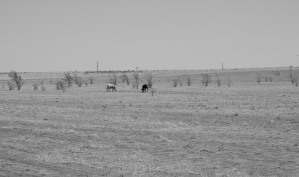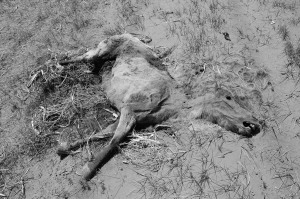The New Dust Bowl
This is an image of the formally fertile Texas Panhandle. These dunes are created by topsoil blown from tilled fields which have received no significant rain for months. We are having frequent dust storms which obscure visual range and cause traffic accidents. And soon, no doubt, we will begin having riotous range fires.
On a typical day in the Spring, sustained winds in Amarillo, Texas may run thirty miles per hour, gusting to sixty. Downslope winds coming from the mountains of New Mexico dry as they expand, wringing any humidity from the air as it travels Eastward. Likewise, air coming in Westward over the Caprock is forced up and cools rapidly, causing precipitation to fall before it reaches us. All this results in nothing but dry, hot air. And it’s getting drier and hotter.
Native plant which grow here are used to little precipitation. This is, after all, a high, arid desert. But with irrigation and an acceptable annual rainfall in the past, this area grew wheat, sorghum, soybeans and cotton. Now, with an average rainfall of less than two inches per month, very little grows here without a huge amount of irrigation. With the dryness of the air, tremendous amounts of water are lost to evaporation before they even hit the ground. The water is wasted, the plants are stunted, the harvests are low. Fields are left with stunted crops unharvested, dried out: fire hazards.
The Panhandle was alive with cattle at one point. Herds of Black Angus, Hereford Whiteface, Longhorns and Limosin roamed the area. But as grazing land dried up, ranchers sold off their herds due to the cost of grains. This is an image of two hybrid cattle on a dusty, overgrazed field. Many of the trees here are dead, the rest twisted to the Northwest from the constant push of the Southwest winds. A fire in this field would spread in an instant, fueled by the bone-dry vegetation and high winds. It would travel faster than these two steers could go, roasting them alive before anyone could get there to help them. It’s happened before.
Firefighters can barely keep up with the fast moving flames. Grass fires create their own winds as the rapidly rising hot air sucks in the relatively cooler air along the ground surface. The firestorm pulls in fuel, oxygen, rocks, and builds strength as it travels. They are hot, they are quick, they are deadly. In Arizona last year 19 firefighters were killed in one blaze alone. Every day we have fire weather warning. We keep our fingers crossed.
The losses suffered are not just financial. This image is of a young foal being covered in the drifting sand is not remarkable in itself. What is frightening about this scene is that at three o’clock in the afternoon, at a temperature of 88 degrees, there was not a single fly on this carcass. Under ordinary circumstances, there would be a visible cloud of them on and over the body. But there were none.
In fact, in 1974 there were grasshoppers, cicadas, dragonflies, ants, praying mantis, bees, wasps, beetles and any number of other insects in the area. Car windshields had to be cleaned of insect parts after a drive in the country. There would be swarms of gnats, mosquitos, mayflies and other flying creatures in the yards, fields and ponds. Now there are not. Our cars are not covered with bugs, just mud. There aren’t roly-polys under the rocks, just sand. Our wasp problems have solved themselves.
As for the birds that used to eat those bugs? They’ve just disappeared. We have the occasional Robin, but the others: meadowlarks, mockingbirds, flycatchers- they’ve moved on. Instead we have sparrows, finches and doves; the seed eaters.
I have a story told to me by a friend about a local rancher and his elderly mother. The rancher went over to his mother’s house during a particularly bad recent dust storm. He found her crying at the window. When he asked what was wrong, she turned to him and said, “This is how it started the first time.”
The geographical center of the Dust Bowl of the 1930s, according to filmmaker Ken Burns, is just short of two hours’ drive from here. There are still a lot of older adults who remember the harsh, dry conditions and the monster, daylight eating dust storms.
They are afraid.
I am too.
Posted on May 11, 2014, in Amarillo, America, cattle, climate change, death, drought, dust bowl, economics, erosion, Flies, heat, insects, Rachel Carson, rainfall, remains, Silent Spring, Texas, wild fires and tagged Amarillo, Boise City, bugs, calf, caprock, cattle, cicadas, climate, death, depression, downslope, drift, drought, dry, dunes, dust, dust bowl, dust storm, erosion, fire, fire storm, firefighters, flies, heat, insects, Ken Burns, Oklahoma, over graze, Panhandle, Rachel Carson, rain, rainfall, sand, survivors, Texas, the great depression, wildfires, winds, windshield. Bookmark the permalink. 3 Comments.



Reblogged this on CrAzY WoMaN! and commented:
Is a new Dust Bowl coming?
LikeLike
… this is a very important document to have out there. Well done Katie
LikeLike
Thank you. It’s getting pretty bad out there. I understand you are having the same kind of problems at your end of the world.
LikeLike